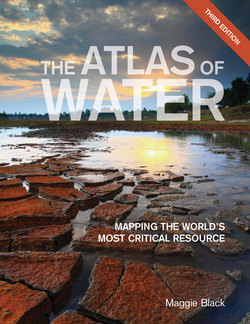Читать книгу The Atlas of Water - Maggie Black - Страница 8
На сайте Литреса книга снята с продажи.
ОглавлениеWater means life – a truism so often repeated that its significance becomes lost. This vital natural resource – falling from the sky, bubbling up into springs and lakes, flowing in streams and rivers – is so fundamental to human activity that everyone must have access to it. Leaving aside questions of unequal power over resources, the very nature of water militates against this. Rain may fall equally “on the just and on the unjust fellow”, but everything depends on where they are standing. There is nothing “just” about annual rainfall distribution, which varies from a few millimetres in some places to thousands in others. And as the climate comes under increasing pressure, the meteorological patterns that scientists have worked for generations to understand are becoming even less predictable. Rainfall, which regenerates all other surface and underground sources, may be about to become even more unjust than before. Rain’s erratic choice of landing place, from deserts to forests, tropical to temperate zones, mountains to valleys, is not the end of this complicated story. Unlike other elements on which life depends, it frequently changes its state – from liquid to vapour, from liquid to ice, and vice versa, depending on the season. Water in lakes and reservoirs is constantly evaporating. And water in the landscape never stands still – it is always on the move. It seeps into the soil for use by plants and creatures, or percolates into aquifers where it renews underground supplies. It travels downhill on even the slightest of gradients. Navigating around whatever impediments it finds in its way, surface water enters a complex system of streams and tributaries, joining an ever larger flow destined for the sea. Many of these linked river networks are occupied by different peoples, states and jurisdictions. At any and every stage along its journey, water is used – and sometimes re-used several times – to support life and economic activity. Maximizing its potential for different uses and environments requires technology, investment, control of pollution, regulation, and efficient service delivery. Take just one example. Rain falling on the Tibetan Plateau finds its way into China’s Lancang river. At many stages downstream, flow is diverted by hydraulic construction and human ingenuity into paddy fields to grow rice. Elsewhere, the speeding stream generates electricity when channelled through hydropower turbines. Towns and cities remove water for human consumption and industry, and discharge wastewater back into it. As the river slows and broadens in its lower reaches, becoming the Mekong, it supports a vast aquatic environment on which local fisherman and wildlife depend. Eventually, it enters the South China Sea, having passed through six countries and been endlessly manipulated and exploited along the way. Heightened demand In an ever more crowded world, the processes involved in this manipulation and exploitation – repeated in countless river basins large and small – are becoming increasingly complex. Much more is being demanded of hard-pressed resources. Rivers are increasingly fragmented by dams. Upstream users reduce both the volume and the
Introduction
